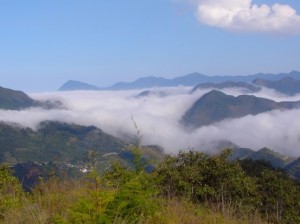 Salvia divinorum (hierba de la pastora, Diviner’s Mint)
Salvia divinorum (hierba de la pastora, Diviner’s Mint)
Of all the plants in the Salvia genus, Salvia divinorum is the most mysterious. It’s endemic to a mountainous region in Oaxaca, Mexico called the Sierra Mazateca. The Mazatec Indians in the area used the leaves of the plant for their divinatory properties in their shamanic curing rituals along with other seeds, plants, and mushrooms. They called it hierba de la pastora “Herb of the Sheperedess” or La Maria “who speaks with a quiet voice.”
Traveling western botanists discovered this plant only in 1962 (Carl Epling and Carlos D. Sativa). They gave the samples to ethnobotanist and mycologist Gordon Wasson and LSD chemist Albert Hoffman who brought it back to the States and began to study the plant’s psychotropic properties.
Salvia divinorum remained hard to find, and only a handful of small populations were ever found. The plant rarely flowers and sets seed. It grows deep in the forest understory near streams and the only way it can propagate itself is vegetatively by layering its stems along the ground until they root. Flowers are white with hairs on a violet or purplish calyx.
The exact natural origins of the plant are still a mystery and it is widely believed to not grow in the wild. Botanically, it is regarded as a cultigen, a plant that has evolved because of humans propagating it rather than through natural selection. Some disagree on this point, however, and claims have been made of viable seed and successful germination. It is believed that Mazatec Indian Shamans would grow the plant in secret locations, and no natural populations exist. The botanists in 1962 were guided by Mazatecs to their own cultivated lots.
Salvia divinorum was one of three plants Mazatec shamans used in their curing rituals along with Psilocybe cubensis (Sacred Mushroom) and Rivea corymbosa seeds(Morning Glory). La Maria was considered a great teacher, and in conjunction with the other two plants, she opened the doors of perception to powerful visions. Their relationship with the plant and the spirit of the plant goes back thousands of years.
Controversy surrounding the plant
Westerners began experimenting with the plants hallucinogenic properties ever since it was brought to the U.S. The 60’s and 70’s saw the emergence of Salvia divinorum amidst all the other hallucinogens and drugs of the time, and a legendary subculture grew. But controversy began too, because many westerners did not respect the spirit of the plant and companies began promoting concentrated eye candy Salvia XXXtract products. Salvia was pushed in head shops by the 80’s and continues to this day to be sold between bongs and dildos. Many use the drug recreationally, at parties, and smoke the leaves as a substitute for weed. And it has gotten a bad rap among the mainstream population because of its misuse. Laws have since been passed illegalizing and restricting the plant in many states, classifying it as a Schedule I substance.
Users often have a confusing experience or experience no effects at all when chewing or smoking the leaves. It seems that the spirit of Salvia must “let you in” before she will extol to you the divinatory virtues of the plant. When taken out of its context of traditional usage, depending on the temperament and experience of the user, it can be an uncomfortable and puzzling experience. Therefore, it is not suggested that the plant be used for hallucinogenic experiences outside the guidance of an authentic and experienced Shaman. Experimenting with Salvia alone for one’s first time or driving while doing so is stupid and dangerous, because the properties of the plant can cause lack of coordination, and the user can be completely “out of this world” for a brief amount of time. It is traditionally taken lying down, in the dark.
The active ingredient in the plant, Salvinorin A is one of the most potent psychotropic properties known to man. However it differs from alkaloid molecules like LSD and Psilocybin that act on the serotonin receptors in the brain. Salvinorin A is pharmacologically known as a diterpenoid. There is a bit of uncertainty over how this molecule takes action on the brain to produce visionary experiences. Salvinorin A should be approached with high caution and respect, because it is very potent, and can cause extremely intense, unpredictable, and highly variable experiences. The extracted molecule, Salvinorin A should only be studied for scientific research. It is recommended that one does not personally experiment with it at all.
It is best to cultivate a sincere respect for Salvia divinorum and the spirit behind the plant. Modern science cannot fully understand this plant, because the true part of it does not exist in the material realm. It defies usage as a recreational drug and we should not treat it as one. Today there is a large community of people who respect this plant immensely, along with many other sacred species. We can grow and conserve this rare species, and develop our own unique spiritual relationship with the plant.
Care instructions
Salvia can be grown quite easily in the home or greenhouse. It prefers shade, water, warmth, and humidity. Allow for air circulation but protect from strong wind because the stems are brittle and break easily. Grow in rich soil with lots of humus. Most pests can be controlled with weekly or monthly applications of Neem oil from the Neem Tree (Azadirachta indica). If you live in a cold environment, take cuttings in late fall before frost and root them indoors in water or a soil-free or perlite/coco coir based mix.
If you have anything to ad, please reply below.